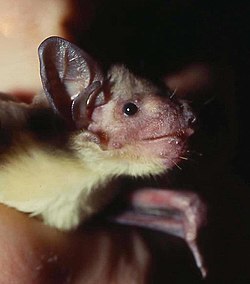Habits
African yellow bats mate in the Austral Autumn in southern Africa and then give birth to twins towards the end of November or early December in the Austral Spring. The young are able to fend for themselves from quite a young age, the females wean then within weeks of birth. African yellow bats show a strong faithfulness to roost sites. [3]
African yellow bats red during the day in hollows and cracks of large trees, their colonies rarely consisted of more than 12 individuals. Roosts are often situated in secluded spots in cracks in walls and roofs and as a result they have become frequent in suburbia. The roosts are normally very quiet and any households who host them are usually blissfully unaware of its presence. They do not normally fly out of the roost until total darkness has descended and they normally feed until they have satiated themselves, usually for around two hours before returning. [3] They sometimes share roosts with the smaller Cape serotine, from which it may be distinguished by its larger wing size and faster flight. [2] They prey mostly on beetles, but also plant-sucking bugs, flies, flying termites, moths and lacewings. [2]
This page is based on this
Wikipedia article Text is available under the
CC BY-SA 4.0 license; additional terms may apply.
Images, videos and audio are available under their respective licenses.

